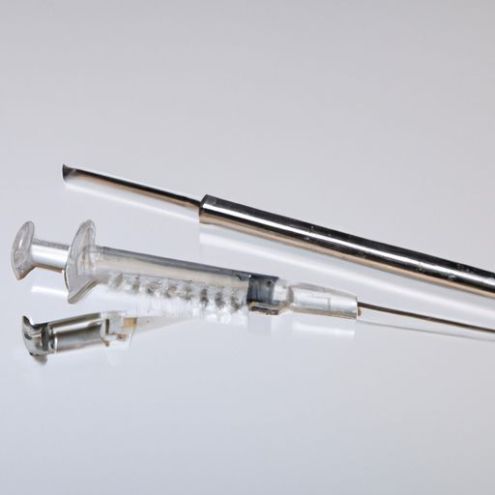Table of Contents
فوائد استخدام المحاقن المعدنية في الطب البيطري
كيفية استخدام محول Luer بإبر الفولاذ المقاوم للصدأ بشكل صحيح في الممارسة البيطرية
أحد أنواع الحقن الشائعة المستخدمة في الممارسة البيطرية هي الحقنة المعدنية، وهي متينة وسهلة التنظيف. غالبًا ما تستخدم المحاقن المعدنية مع الإبر المصنوعة من الفولاذ المقاوم للصدأ، والتي تتميز بحدتها ودقتها. لتوصيل إبرة من الفولاذ المقاوم للصدأ بمحقنة معدنية، يتم عادةً استخدام محول luer. محول luer عبارة عن قطعة صغيرة مخروطية الشكل تسمح بربط الإبرة بشكل آمن بالمحقنة.
عند استخدام محول luer مع إبر الفولاذ المقاوم للصدأ في الممارسة البيطرية، من المهم اتباع بعض الخطوات الأساسية لضمان ذلك يتم توصيل الإبرة بشكل صحيح وأن الإجراء يسير بسلاسة. أولاً، تأكد من أن المحقنة والإبرة نظيفتان وخاليتان من أي حطام. سيساعد ذلك على منع التلوث وضمان سلامة الحيوان المريض.
بعد ذلك، قم بإزالة الإبرة بعناية من عبوتها، مع الحرص على عدم لمس الطرف الحاد. قم بتوصيل محول luer بنهاية المحقنة عن طريق لفه بشكل آمن. بعد ذلك، ادفع الإبرة برفق على محول اللوير حتى تثبت في مكانها. تأكد من إمساك الإبرة من المركز، بدلاً من الطرف الحاد، لتجنب التصاق الإبرة عن طريق الخطأ.
بمجرد توصيل الإبرة بالمحقنة، من المهم التحقق من أي تسرب أو مشاكل أخرى قبل متابعة الإجراء. للقيام بذلك، اسحب كمية صغيرة من السائل إلى المحقنة ثم ادفعها للخارج. إذا كان هناك أي تسربات أو فقاعات أو مشاكل أخرى، قم بإزالة الإبرة ومحول اللوير وابدأ مرة أخرى بإبرة جديدة.
عند إعطاء دواء أو لقاح باستخدام حقنة بإبرة من الفولاذ المقاوم للصدأ ومحول اللوير، من المهم: اتباع التقنية المناسبة لضمان سلامة وراحة المريض الحيوان. أمسك المحقنة والإبرة بالزاوية الصحيحة وأدخل الإبرة في الموقع المناسب على جسم الحيوان. ادفع المكبس ببطء لإعطاء الدواء، مع الحرص على عدم الدفع بسرعة كبيرة أو بقوة.
بعد اكتمال الإجراء، أخرج الإبرة بعناية من جسم الحيوان وتخلص منها بشكل صحيح في حاوية الأدوات الحادة. قم بإزالة محول luer من المحقنة ونظف كلاً من المحقنة والإبرة جيدًا قبل تخزينهما للاستخدام المستقبلي.
في الختام، يعد استخدام محول luer مع إبر الفولاذ المقاوم للصدأ في الممارسة البيطرية إجراءً شائعًا ومهمًا. من خلال اتباع الخطوات المناسبة لربط الإبرة بالمحقنة، والتحقق من وجود تسربات، وإدارة الدواء أو اللقاح بشكل صحيح، يمكن للمهنيين البيطريين ضمان سلامة ورفاهية مرضاهم من الحيوانات. تعتبر التقنية المناسبة والاهتمام بالتفاصيل أمرًا أساسيًا عند استخدام المحاقن والإبر في الممارسة البيطرية.
How to Properly Use a Luer Adapter with Stainless Steel Needles in Veterinary Practice
Veterinary professionals rely on a variety of instruments to provide the best care for their animal patients. One essential tool in any veterinarian’s arsenal is the syringe, which is used for administering medications, vaccines, and other treatments. When it comes to using a syringe with a needle, it is important to ensure that the needle is properly attached to the syringe to prevent any leaks or other issues during the procedure.

One common type of syringe used in veterinary practice is the metal syringe, which is durable and easy to clean. Metal syringes are often used with stainless steel needles, which are known for their sharpness and precision. To attach a stainless steel needle to a metal syringe, a luer adapter is typically used. A luer adapter is a small, cone-shaped piece that allows the needle to be securely attached to the syringe.
When using a luer adapter with stainless steel needles in veterinary practice, it is important to follow a few key steps to ensure that the needle is properly attached and that the procedure goes smoothly. First, make sure that both the syringe and the needle are clean and free of any debris. This will help prevent contamination and ensure the Safety of the animal patient.
Next, carefully remove the needle from its packaging, being careful not to touch the sharp tip. Attach the luer adapter to the end of the syringe by twisting it on securely. Then, gently push the needle onto the luer adapter until it is firmly in place. Be sure to hold the needle by the hub, rather than the sharp tip, to avoid accidental needle sticks.
Once the needle is attached to the syringe, it is important to check for any leaks or other issues before proceeding with the procedure. To do this, draw a small amount of liquid into the syringe and then push it back out. If there are any leaks, bubbles, or other problems, remove the needle and luer adapter and start again with a new needle.
When administering a medication or vaccine using a syringe with a stainless steel needle and luer adapter, it is important to follow proper technique to ensure the safety and comfort of the animal patient. Hold the syringe and needle at the correct angle and insert the needle into the appropriate site on the animal’s body. Slowly push the plunger to administer the medication, being careful not to push too quickly or forcefully.
After the procedure is complete, carefully remove the needle from the animal’s body and dispose of it properly in a sharps container. Remove the luer adapter from the syringe and clean both the syringe and needle thoroughly before storing them for future use.
In conclusion, using a luer adapter with stainless steel needles in veterinary practice is a common and important procedure. By following the proper steps for attaching the needle to the syringe, checking for leaks, and administering the medication or vaccine correctly, veterinary professionals can ensure the safety and well-being of their animal patients. Proper technique and attention to detail are key when using syringes and needles in veterinary practice.
